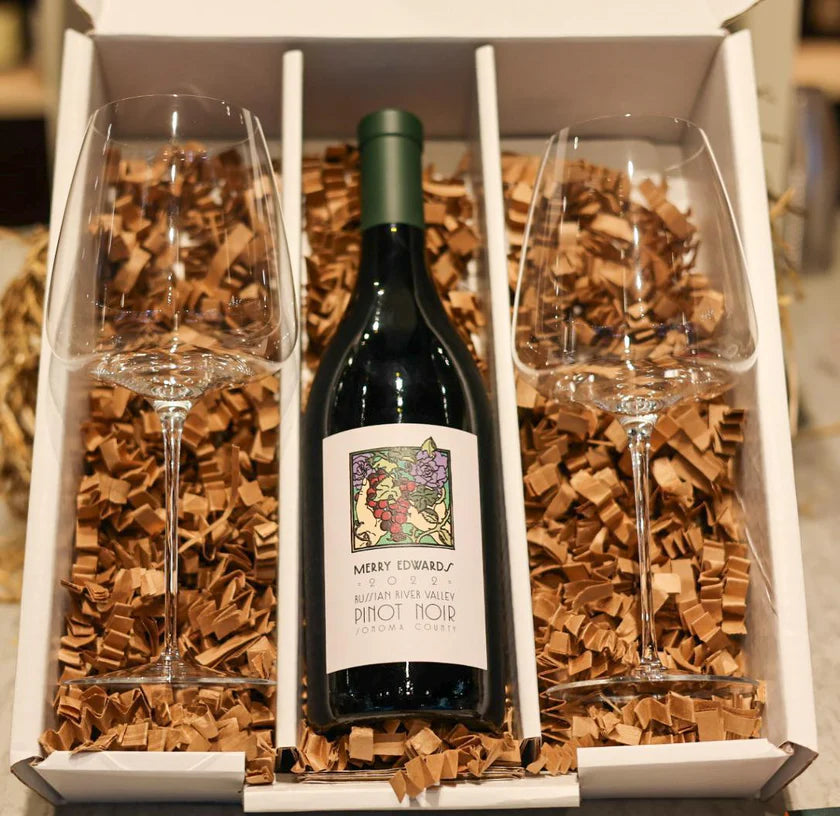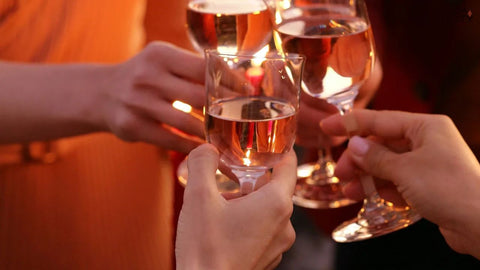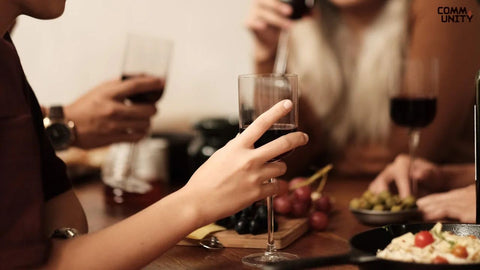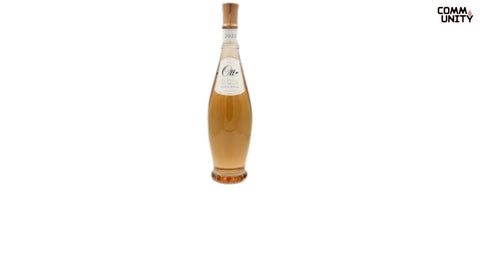Understanding how many ounces are in a glass of wine is essential for not only wine lovers, but also for servers and anyone mindful of having proper serving etiquette.
Whether you're enjoying a casual evening at home or hosting a formal dinner, knowing the standard pour size and the variables that influence the number of ounces in a glass of wine ensures a refined experience.
In this guide, we explore standard serving sizes, wine glass types, alcohol content, and more so you're never left guessing how many ounces for a glass of wine is appropriate.

Merry Edwards Russian River Valley Pinot Noir with Set of 2 Italesse Crystal Pinot Noir Glasses
Standard Wine Pour in Ounces
The standard serving size for a glass of wine in the U.S. is 5 ounces. This standard of 5 ounces in a glass of wine is established by the Centers for Disease Control and Prevention (CDC) and the United States Department of Agriculture (USDA). It’s used across restaurants, wine bars, and official guidelines for alcohol consumption.
-
Red wine: 5 ounces per serving
-
White wine: 5 ounces per serving
-
Rosé wine: 5 ounces per serving
-
Dessert wine: Often poured at 2 to 3 ounces due to higher alcohol and sugar content
Why 5 Ounces? The Logic Behind the Standard
The 5-ounce pour correlates with the average alcohol by volume (ABV) in wine, which ranges from 11% to 14%, depending on the variety and region. Since most wine falls within that range, a 5-ounce serving contains roughly 12% ABV, or about 0.6 ounces of pure alcohol, aligning with liquor guidelines.
Different Wine Glasses and Pour Sizes
Not all wine glasses are created equal, and their shape and capacity can mislead the eye. Below is a breakdown of various wine glass styles and how their volume capacity can differ from the actual pour size.
|
Wine Glass Type |
Capacity (oz) |
Standard Pour (oz) |
|
Red wine glass (large bowl) |
12–22 oz |
5 oz |
|
White wine glass (smaller bowl) |
10–14 oz |
5 oz |
|
Champagne flute |
6–10 oz |
4–5 oz |
|
Dessert wine glass |
4–6 oz |
2–3 oz |
|
Stemless wine glass |
15–20 oz |
5 oz |
While a red wine glass may hold up to 22 ounces, professional servers pour only a quarter or less of its capacity, which allows room for aeration and aroma concentration.
Visualizing a 5-Ounce Pour
If you’re pouring wine at home and don’t have a measuring cup, a few reference points can help:
-
A standard kitchen measuring cup can easily portion out 5 ounces.
-
Most restaurants pour until about the widest part of a wine glass bowl but often use a carafe to serve.
-
Visually, a 5-ounce pour is roughly one-quarter of a typical red wine glass and just under halfway for a white wine glass.
Comparing Wine to Other Alcoholic Beverages
Understanding the equivalent alcohol content across beverages can provide helpful context.
-
Wine (12% ABV): 5 ounces
-
Beer (5% ABV): 12 ounces
-
Spirits (40% ABV / 80 proof): 1.5 ounces
Each of these servings contains approximately the same amount of pure alcohol, about 0.6 ounces. This standardization ensures consistency in responsible drinking guidelines.
How Many Glasses in a Bottle of Wine?
A standard wine bottle contains 750 milliliters, which is equivalent to 25.4 ounces. Based on the 5-ounce standard pour:
-
One 750ml bottle of wine = Five 5-ounce glasses
This calculation can change slightly with overpours or underpours, especially in informal settings. Here's a breakdown:
|
Bottle Size |
Volume (mL) |
Total Ounces |
No. of Glasses |
|
Standard |
750 mL |
25.4 oz |
5 glasses |
|
Magnum |
1.5 L |
50.8 oz |
10 glasses |
|
Half bottle |
375 mL |
12.7 oz |
2.5 glasses |
|
Double Magnum |
3 L |
101.6 oz |
20+ glasses |
Serving Etiquette: How to Pour the Perfect Glass
Pouring wine isn’t just about measurement, it’s also about presentation and experience. Here's how to pour correctly:
-
Hold the bottle at the base, using your dominant hand.
-
Tilt the glass slightly and pour slowly to avoid splashing.
-
Aim for the widest part of the glass bowl, not the rim.
-
Never fill a wine glass more than halfway.
-
For sparkling wines, pour down the inside wall of the flute to preserve bubbles.
This method enhances aroma release, flavor integrity, and visual appeal.
Factors That Affect Serving Size
While 5 ounces is the standard, several variables can influence how much wine is poured:
-
Alcohol Content: Wines with higher ABV (14%+) may be poured slightly less.
-
Occasion: Tastings may involve 2-ounce pours; dinners may have full 5-ounce servings.
-
Glassware Type: Larger glasses can lead to heavier pours if not measured.
-
Service Style: Casual settings often result in generous, unmeasured servings.
Wine Tasting Events
At professional tastings, pours are often limited to 1 to 2 ounces per sample, which are much smaller pours than the regular 5-ounce pours. This allows participants to try multiple wines without excessive alcohol intake. A typical wine tasting flight may consist of:
-
4–6 types of wines and around 1.5 oz each
-
Total: 6–9 oz
These events focus more on aroma, palate, and finish rather than quantity.
Wine Serving Tools That Help with Accuracy
To ensure consistent serving sizes, many use the following tools:
-
Measured pourers: Attach to the bottle for exact ounces
-
Wine aerators with measurement markings
-
Wine glasses with discreet pour lines to mark ounces in a glass of wine
These tools are especially helpful in restaurants or events with consumption limits.
Final Thoughts
A glass of wine typically contains 5 ounces, a standard that aligns with national guidelines and industry practices.
Whether you’re tracking consumption, managing calories, or are just curious to know more, understanding the true pour size empowers better decisions and enhances the overall wine experience. While glasses may vary in shape and volume, the 5-ounce benchmark remains the cornerstone of wine service and etiquette across the world.
Shop for the best wines from Community Wine and Spirits and classy glassware to serve your drink at your next get together and don’t forget to have fun!


